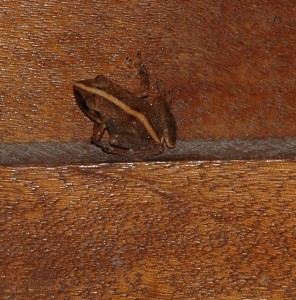“In wildness is the preservation of the world.”
~ Henry David Thoreau
If a diverse ecosystem is a reflection of a healthy environment, then our valley must be maintaining a sense of balance within a developing world. It is often hard to exist within nature without getting overwhelmed by the compromises one must make in order to survive here. Our little corner of dwelling is so minute in comparison to the amount of bush that surrounds us. We are often reminded that we are the guests in this habitat.
This season we have been visited by many of our wildlife residents. We do not often see the local Tete Chien, (Boa constrictor nebulosus), but we know they live within the stony corners of the property as they cross our path about once a year.
Unfortunately, many of our visitors would like to see them but part of their survival technique is to not be seen. They are masters of the element of surprise, disguising themselves as slippery tree roots under the bush. This year was the exception however. After ten years of raising chickens without interruption, we had our first snake attack in the coup. The female had slithered her way through a small hole in the screen, ate two whole layer chickens and couldn’t get back out the door she came in. As much as we do not like to loose a chicken we still unde
rstand that this is part of the life~death~life cycle. To the absolute disbelief of our less compassionate neighbors, we shooed the snake back into the bush with a broom stick. The powerful muscle of the reptile grabbed hold of the stick and shook it back at Ron with enough force to leave a mark on his arm. Up to now we have not seen her again.
Another favorite resident not often seen is our beloved Iggy, the Lesser Antillean Iguana (Iguana delicatissima).

We first spotted Iggy about three years ago on the sidewalk behind the kitchen. We had never seen him before but he (or she?) had already grown to a mature size in our backyard. Being a chartreuse creature in a melee of forest green, we consider seeing Iggy as a sighting. His next appearance was just before a storm, as he surveyed the gray swirling sky while swaying atop a papaya branch. It was a long time after that we saw him again and we had feared that the storm drove him coastal. But alas, more drama, his next appearance was eye to eye with our new kitten Robbie. It was a stand off and a stare down, both creatures in awe, that resulted in a mutua
l backing down. Again, we feared his time limited. Months passed until we saw him again but there were signs of his presence as carrot tops were eaten and potatoes rooted out. His last visit happened when a dry branch fell under his claw and exposed him within inches of the mangoes that dangled from his tree home. There is always something comforting in seeing Iggy, like a peaceful awareness that we can live so close and yet so deeply in our own worlds.

Although we hear the “tink tink” of the Gounouj (Eleutherodactalus martinicensis) frogs, they typically do keep to moist and dark places. This extensive dry season we had though brought them right inside searching for watering holes. Our house frog, who has lived with us long enough now to warrant a name, has taken up residence in our overflow drain in our bathroom sink. She only peeks her head out at night and sometimes even has company. Despite the rambunctious water play that goes on with a three year old boy washing his hands, this little frog is still calling our sink her home.

With the return of the rains comes the return of the foliage on many of our thirsty ornamental shrubs. In the afternoon drizzle, the monstrous Frangipani caterpillars (Pseudosphinx tetrio) are back and munching away the milky leaves of the Almanda flowers as fast then the greenery can unfold.
Seeing these neighbors busy in their natural routines resonates a reassurance that the wild life, as well as the human life, is still able to guide its wheel along the narrow course of a healthy life. Though this special Nature Island is but one corner of a very busy world, we take faith in the words of environmental journalist Michael Smith: “It’s now widely accepted that a biodiversity – rich place, when properly protected, will seed biodiversity elsewhere.”
